| |
ID |
Date |
Author |
Type |
Category |
Subject |
|
|
32
|
Mon May 23 15:58:30 2011 |
Mike Bentley | Routine | General | End of Shift summary |
OK - summary of events during this shift.
1.TDCs. We have been sorting offline, and we have now established that between run 66 and run 79, the TDC mode was incorrectly set (not in common stop mode) after a DAQ crash causing broad loci in the E vs T spectra and times of the wrong sign. This was corrected from Run 81 onwards.
2. The offline sort is behaving very badly and many of the sorts run since yesterday to now are wrong. Make sure you (a) sort on a different machine than the DAQ and (b) make sure that the sort is killed each time you start a new sort and (c) make sure that it is sorting the righrt run number.
3. We have changed the trigger to a coincidence (S2-1 plus S2-2) OR S2-2 on its own OR PD.
4. We have increased the beam rate to about 120 epA and we stay on this. Trigger rate should be about 7K with 4K live time.
5. We will not change energy until early morning tomorrow, at the earliest. we will make a decision during the next two shifts based on what we see in the sort.
Mike |
|
|
36
|
Tue May 24 08:18:23 2011 |
Mike Bentley | Routine | General | end of shift summary |
We have been running smoothly all night. Only problem is that the DAQ occasionally does not start properly after a stop-go. The dead-time goes to nearly 100%. This happened twice in the night,. and a second stop-go did the trick. Needs looking at.
We are going to stop now and (a) check the tune properly and (b) retune if necessary and then carry on the same energy. There is not really evidence in the data of the structure we are looking for, so we need to carry on at this energy for a while. This process will take 6 hours or so
MAB |
|
|
37
|
Tue May 24 20:45:12 2011 |
Mike Bentley | Other | General | Update for during the day 24th May, wednesday |
Update:
W decided at 8.00 to stop, check the tune, retune and get back going. This has nearly, finished but it is a very long process indeed - note for future - this takes AT LEAST 12 hours, if one is systematic about it.
We tested the tune as it was - it was OK, (90% transmission or so acdording to a straight ratio of the cups) but there are a fair bit on the 4mm collimator.
Marco then tuned, and improved it with a high intensity tune, reduced the rate on the collimator by at least a factor of 5 - maybe more. Good position on scintillator - see photo below.
We have since pumped out and run several tests with the window in, but no gas: (1) 10mm collimator on first target ladder, nothing on second - transmission was about the same, measured the same way. Rate similar to same test we did a couple of days ago. (2) 5mm collimator and blank second target - result about the same. (3) 5mm collimator and scintillator in - photo below. Beam spot blew up a bit compared with no gas. See below. (4) 5mm collimator and PD2 (5) 5mm collimator and blank. Ran this to disk. and (6) CH2 target. This made no sense and we got a lot of horrible ate of this so we stopped it.
We saw noise in S2-2 when we had no gas. It was bad - 1200Hz with no beam - all from S2-2. When we put gas in, it all went away! We suspect that it was a gauge that we disconnected, perhaps.
Waiting for beam, as buncher has now tripped.
Note that full cycle (pump, flush, vent, tune, flush, pump H2) - with all the tests as you go along, took 12 hours!
The pictures below are tunes without and with the window. From Mikes iphone. !
|
| Attachment 1: photo-7.png
|
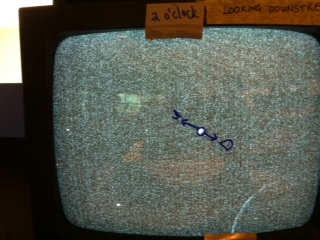
|
| Attachment 2: photo-8.png
|
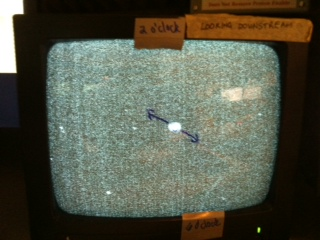
|
|
|
41
|
Wed May 25 18:05:55 2011 |
Mike Bentley | Routine | General | Report on day shift and changed energy - now at 3.98 MeV/u |
All ran smoothly.
As a test, ran for a short period at 1200 midday to run without S2-2 in the trigger. Finished that at 1339.
After discussion with Alison, Alex, Brian, Chris - we decided to change energy to 3.98 MeV/u. This started at 1340.
Pumped out H2, Marco steered with low intensity beam. He optimized on our PD2 with the 3mm collimator, then he observed the spot on the scintillator. He believed (as do I) that it looked as good as it did after the high-intensity tune yesterday. Beam spot blown up a bit, as before, but very well centred. picture from iphone below.
Did a run without gas, then filled, then got going on H2. H2 run started 1730. Thus, 4 hours for beam change and low-intensity tune.
Did analysis of rates/triggers with and without gas - all with 100 epA
WITHOUT GAS WITH GAS
S2-2 all 3000 3800
PD 1500 1900
Coincidence 10 1800
S2-1 all 13000 57000
The trigger (7000 ish) is a sum of the first three of course. Interesting that all the coincidences are gas-"related" - which is good I think. It confirms to me that we should consider, at some point, running on only coincidences in the trigger to cut down the dead time (currently 60% live, 40% dead)
that's it. Jamie checking the spectra, if nothing else in this e-log then they are ok.
Sort started on new data, will run it overnight and compare in the morning with the old sort.
Mike |
| Attachment 1: photo.png
|
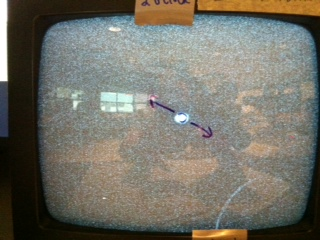
|
|
|
50
|
Sat May 28 07:46:09 2011 |
Lars Martin | Routine | General | |
Beam current dropped to 85 epA at the start of the shift, operator checked for reasons and decided to change
stripper foil. That brought the current back up, but it started decreasing again, so from run to run slits were
gradually opened further to keep FC0 current at about 100 epA.
I forgot the part about saving and clearing the spectra after every run, so runs 171-177 were summed together. |
|
|
54
|
Wed Jul 18 08:29:03 2012 |
Jessica Tomlinson | Other | General | Analysis update |
Energy calibration for S2-2 was done using the pulser data (set 6 of the pulser runs) to calculate the offsets and alpha run R186 to calculate the gains and constant. For S2-1 pulser walkthrough 6 was also used to calculate the offsets and the gains calculated using run 31 which is 21Ne beam scattering from Au/C target. The constants were then calculated by fitting a least squares fit to the alpha peaks from run 186 and the gold scattering peak from run 31 energy vs peak position plot.
TDCs were calibrated with different sources for each detector. For S2-1 the offsets were calculated using the TDC spectra for the 21Ne on Au/C (Run 31) data. For S2-2 the run 23 was used which is a pulser run.
Currently applying equal energy and coincidence cuts to the data and plotting using Monte Carlo to compare to what I am seeing in the data. Plotting things such as Energy in S2-1 vs Energy in S2-2, back strip in S2-1 vs back strip in s2-2, energy sum. |
|
|
55
|
Mon Sep 24 07:16:18 2012 |
Jessica Tomlinson | Other | Other | Analysis update |
Energy vs Time plots
I updated the monte carlo written by Alex to include time and also created new SRIM tables for 250 Torr rather than 300 Torr. I ran the Monte Carlo for a beam energy of 4.44MeV/u and plotted energy vs time for each detector. It should be noted that there are 2 codes, one for scattering 21Ne(p,p)and one for the reaction 21Ne(p,a) and the number of scattered particles as opposed to the number of reaction products from (p,a) are not what is expected in the data but the energies and timing are.
Attachment 1 shows energy vs time in S2-1 (downstream-heavy ion detector) from the data runs at 4.44Mev/u. Beam pulses are 85ns apart. The cuts on this include: equal energy cuts between the front and back of each detector removing interstrip hits, coincidence hits between S2-1 and S2-2, must be a hit in the front and back of each detector, phi cut so that particles must hit S2-1 and S2-2 at 180 degrees to one another. A feature not shown in the monte carlo is the second weaker line of particles, hitting the detector just after the first stronger line. I am not sure what this is, could be beam scattering off the entrance window or from N gas left over in the chamber?
Attachment 2 shows the same plot (energy vs time) simulated with the monte carlo for scattering reactions and for the (p,a) reaction. This shows that the reaction is dominated by beam scattering from the target H2 gas. The 18F extends to lower energies as shown in the monte carlo and there are some lower energy points in the data (Att 1) which could correspond to this, however I am not sure whether this is F or beam scattering from the entrance window which also produces an extended range of energies.
Attachment 3 shows energy vs time data plot in S2-2(upstream - light ion detection), at same energy and with same cuts as for s2-1 in Att 1. Again comparing this to attachment 4 which shows the Monte Carlo calculated energy vs time plot for S2-2 the data is dominated by scattering events. The small number of events which happen after 8.5 Mev (protons will punch through the detector after this) could be alphas. The Monte Carlo shows the alpha particles have a wider energy range than the protons.
Other plots
I ran a 'gas out' data set to see how much scattering was coming from the entrance window to the chamber. There is no gas out run for 4.44 MeV/u so I used the one at 4.11MeV/u. This shows that there was some scattering from the window getting through the cuts described above, in S2-2 they go no higher than 8 MeV which makes me think it is scattering with protons because of the punch through energy. To check it was from the window I checked a run where there was no target and no window in the chamber and saw nothing after the cuts above.
Other plots I am looking at include: time(S2-1) vs time (S2-2), energy(S2-1) vs energy(S2-2), energy vs strip for each detector, time of flight difference between S2-1 and S2-2 vs energy difference between two detectors, difference in theta (front strip) vs sum energy of two detectors, time of flight vs energy difference.
eol |
| Attachment 1: S21evst_data.pdf
|
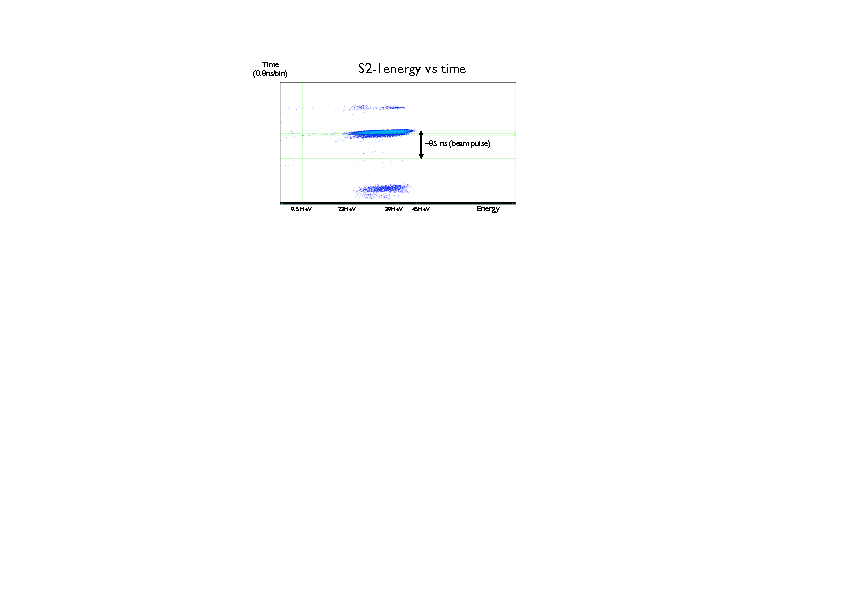
|
| Attachment 2: S21evst_mc.pdf
|
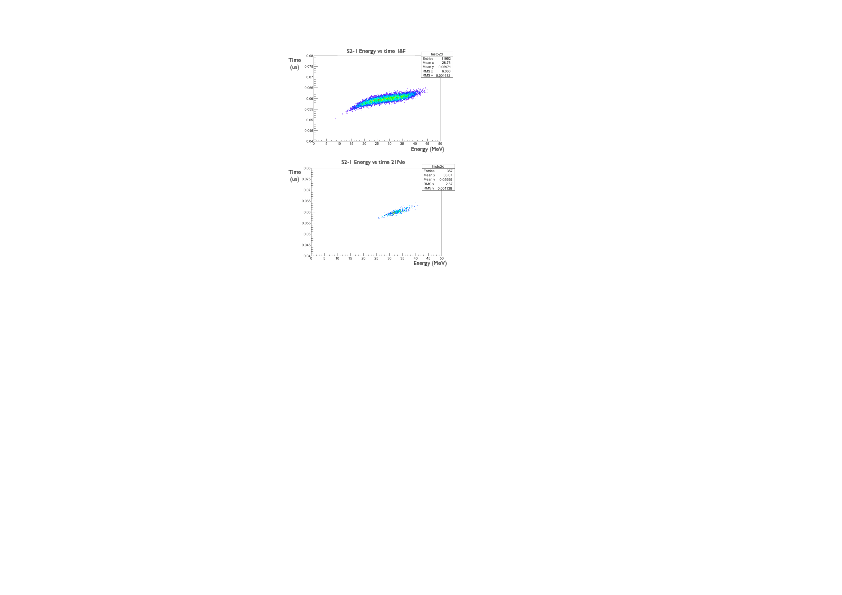
|
| Attachment 3: S22evst_data.pdf
|
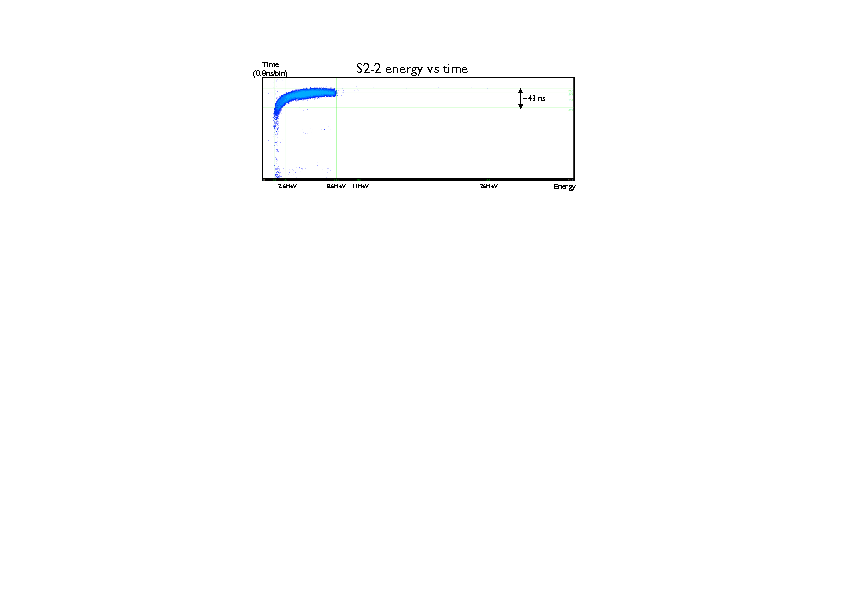
|
| Attachment 4: S22EvsT_mc.pdf
|
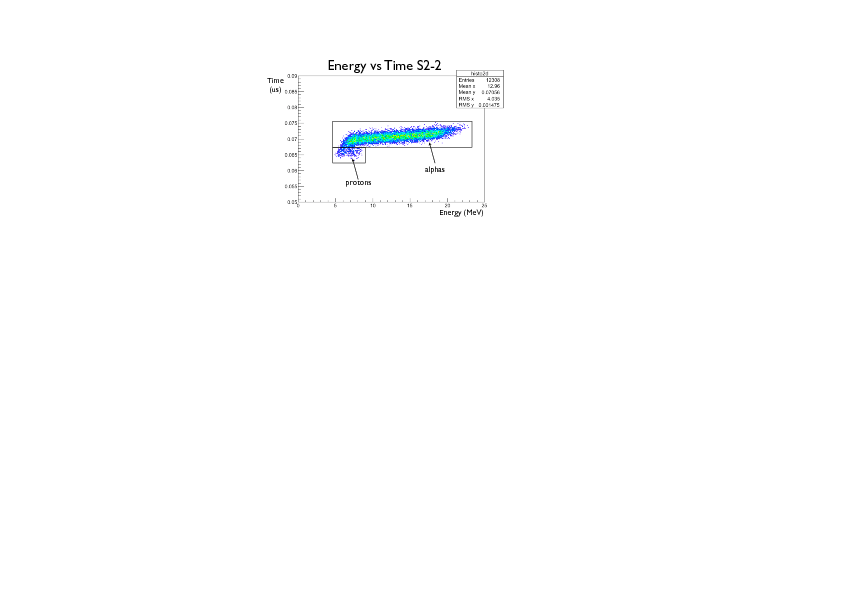
|
|
|
57
|
Fri Nov 16 07:12:32 2012 |
Jessica Tomlinson | Other | General | 4.11 MeV/u analysis |
I have sorted the 4.11MeV/u data runs (the ones which had the common stop mode on the TDCs) and applied the following cuts:
- There must be a hit registered in each side of the detectors.
- equal energy must be deposited in both sides of the detectors.
- Low energy cut is applied to each detector.
- Must have a hit in the TDC for the front strips.
- Must have multiplicity greater than 3.
- Must have hits in both S2-1 and S2-2.
- Particles must hit at 180 degrees to in the detectors. (back spoke cut)
Looking at the back spoke in S2-1 vs back spoke in S2-2 plot cut number 7 should be changed to +/- 3 back strips to ensure no particles are being cut out due to position straggling in the gas.
Plotting S2-2 energy vs time with these cuts gives attachment 1. I need to redo the timing calibration for S2-2 as strip 96 has the wrong offset and the resolution needs to be improved. The protons can be seen clearly as they punch through the detector and around 8MeV. I have also attached as attachment 2 the monte carlo plot for S2-2 at this energy. There are two monte carlo codes one for 21Ne beam scattering and one for the reaction which means the number of each type of event are not correctly proportional, in the data there is far more scattering. Here you can see the protons from ~4-8MeV lying underneath the alpha line. The time spread in the actual data of the proton/alpha line is about 25ns whereas in the monte carlo it is about 10 ns for combined alpha and protons.
Because the protons will punch through the detector at approx 8MeV I believe that the points after this could be alphas. Attachment 3 shows the projection for the polygon which selects particles after the protons in the energy vs time plot. As can be seen from the energy projection the energy dips where you would expect it to for alphas, however there are some higher energy points and I am not sure what these might be.
I then plotted Energy vs time in S2-1 gating on energy in S2-2 greater than 8.2MeV. This plot is shown in attachment 6. Attachment 4 shows the Monte Carlo simulated energy vs time for 18F in S2-1, with attachment 5 shows simulated energy vs time for scattered 21Ne in S2-1. I plotted these separately as they have the similar timing and so cant be seen separately on the same plot. Here you can see the 21Ne clearly in the data, so some of the protons are depositing more than 8.2 MeV in S2-2. If I change the cut so that the energy in S2-2 must be greater than 9MeV and plot energy vs time for S2-1 again the 21Ne is no longer visible (will not let me attach this file due to capacity so I will attach it in a new elog entry straight after this one). The energy spread of the points in the S2-1 energy vs time plot cut on what could be alphas in S2-2 gives the correct energy spread for 18F in the monte carlo simulated data.
Next:
- Redo timing calibration for S2-2
- Look at gas out run
- Work out how to separate lower energy alphas and protons
- Work out what higher energy points in S2-2 could be.
|
| Attachment 1: s22-evst.001.png
|
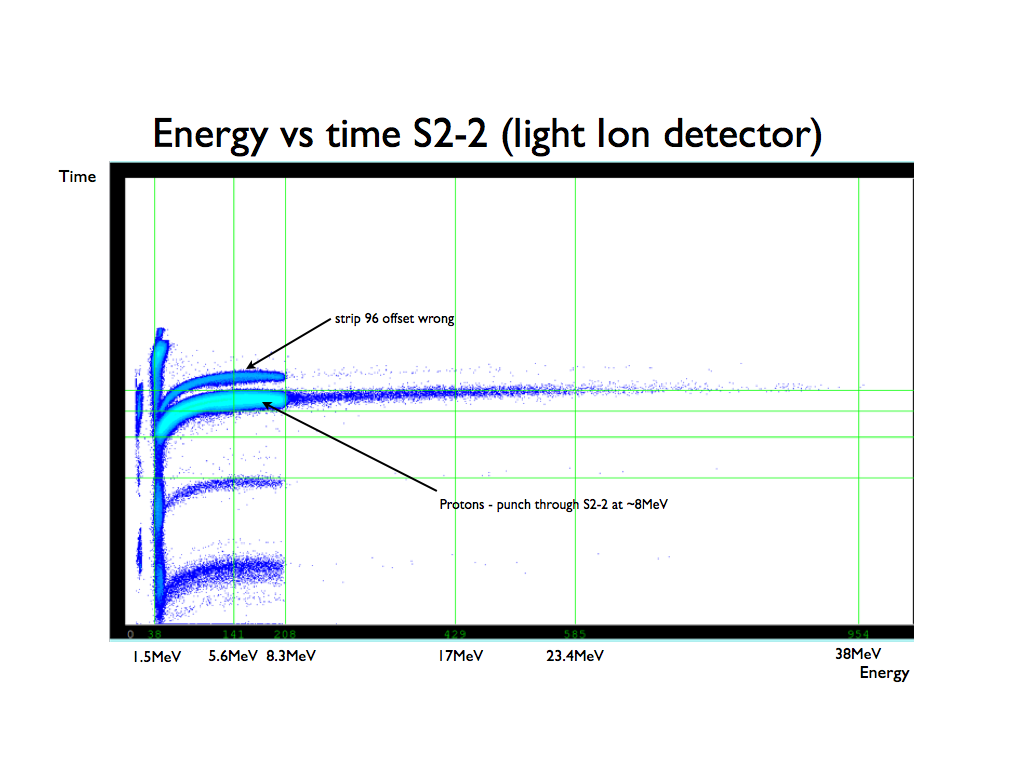
|
| Attachment 2: Evst-panda-S2-2.png
|
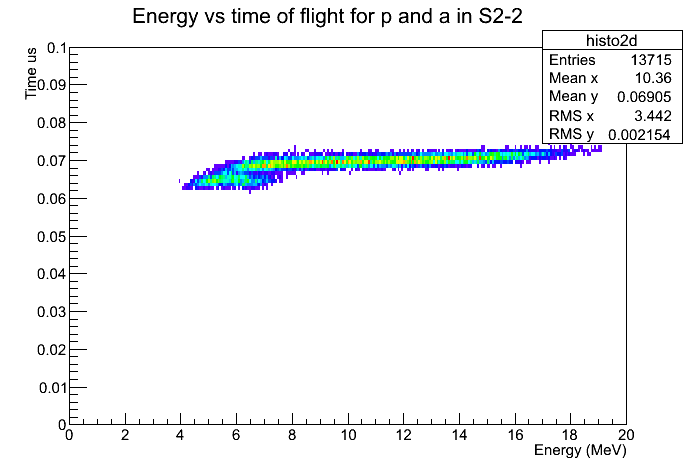
|
| Attachment 3: Evst-S22-projection.001.png
|

|
| Attachment 4: Evst-F-s21.png
|
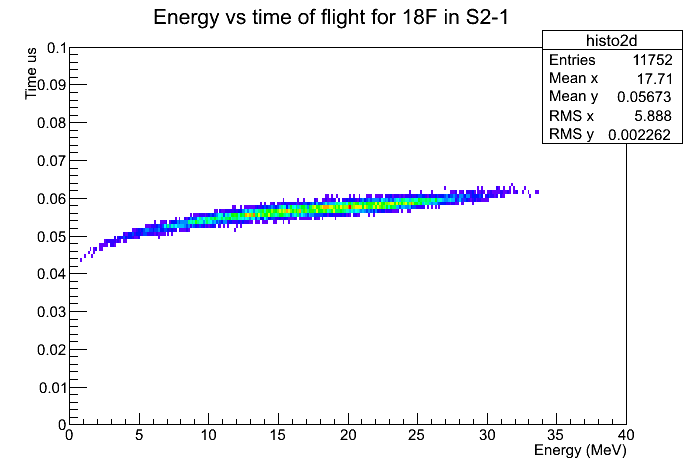
|
| Attachment 5: Evst-Ne-S2-1.png
|
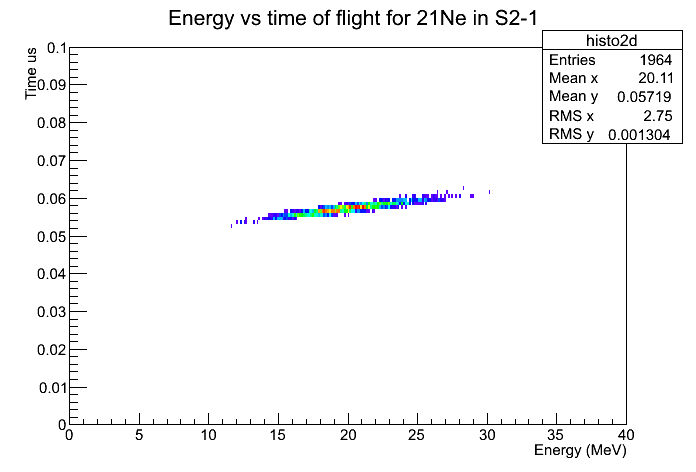
|
| Attachment 6: S2-1-evst-8.2cut.001.png
|
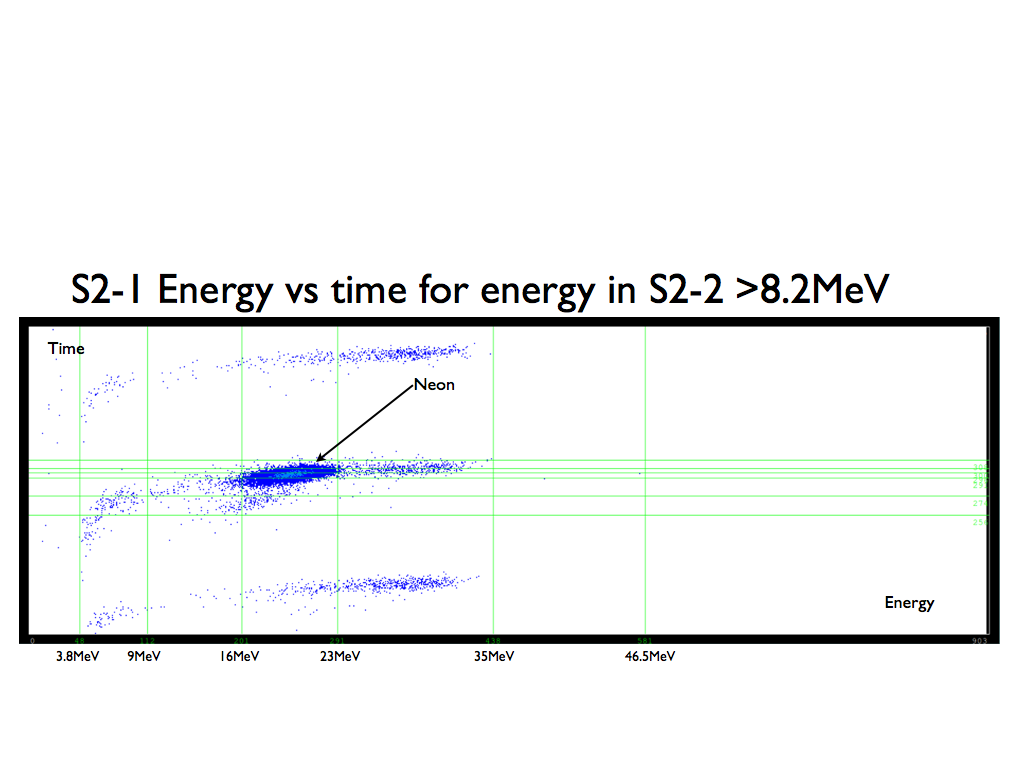
|
|
|
58
|
Fri Nov 16 07:23:26 2012 |
Jessica Tomlinson | Other | General | S2-1 plot that would fit on previous elog |
Attachment 1 shows S2-1 energy vs time with a gate on energy in S2-2 being greater than 9MeV i.e. See previous elog also posted today for explanation.
|
| Attachment 1: S2-1-evst-9mevcut.001.png
|
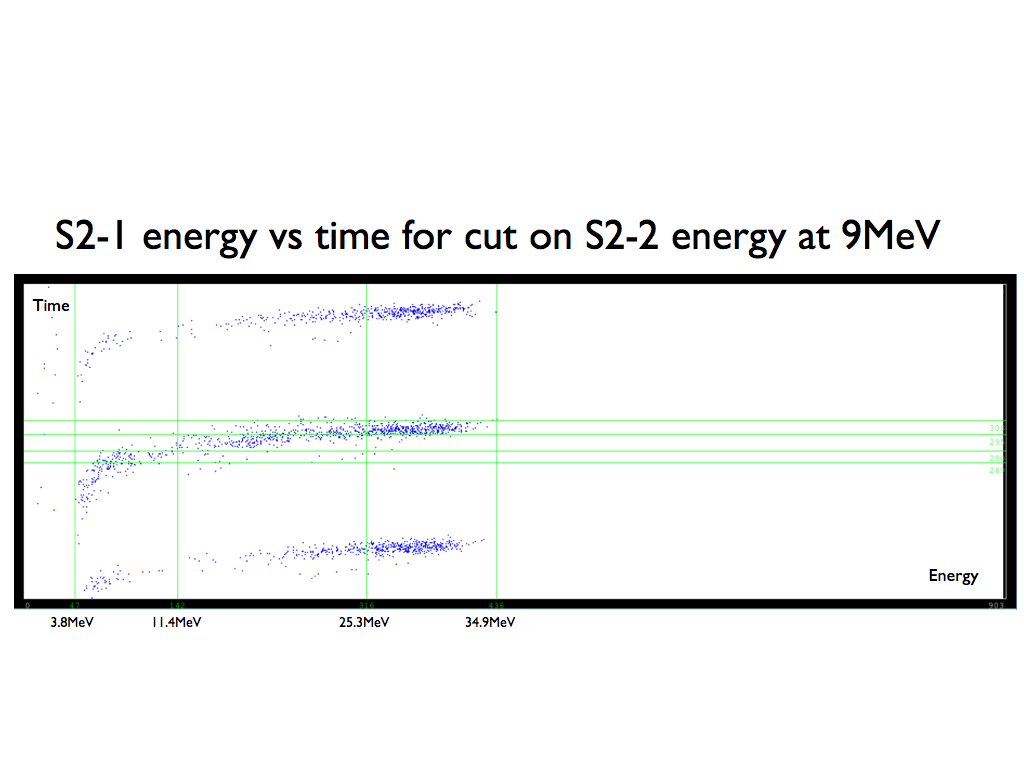
|
|
|
59
|
Tue Dec 4 05:40:10 2012 |
Jessica Tomlinson | Other | Other | analysis - single strip E vs t |
I have attached some single strip energy vs time plots to show that the structure seen in the collective E vs t plots is in each strip.
Attachments 1 and 2 show two different strips in S2-2 with no cuts. You can see that the 3 loci are different to one another in the single strips as well as in the combined S2-2 E vs t plot shown in attachment 3. Attachement 3 is plotted after applying the following cuts: equal energy in the front and back of each detector, low energy cut, must be a hit in each detector, multiplicity must be greater than 3. The 3 different loci are a beam pulse apart. The energy cal is 40keV/chan.
Attachments 4 and 5 show energy vs time for single strips in S2-1 with no cuts. Attachment 6 shows the combined front strips in S2-1 after the same cuts as above for the combined S2-2 plot have been applied. Now there are 2 loci in the same beam pulse which are still there after the cuts. Not sure what the second line is. The energy cal in attachment 6 is 80keV/chan. |
| Attachment 1: s2077-evst-s22-1strip.png
|
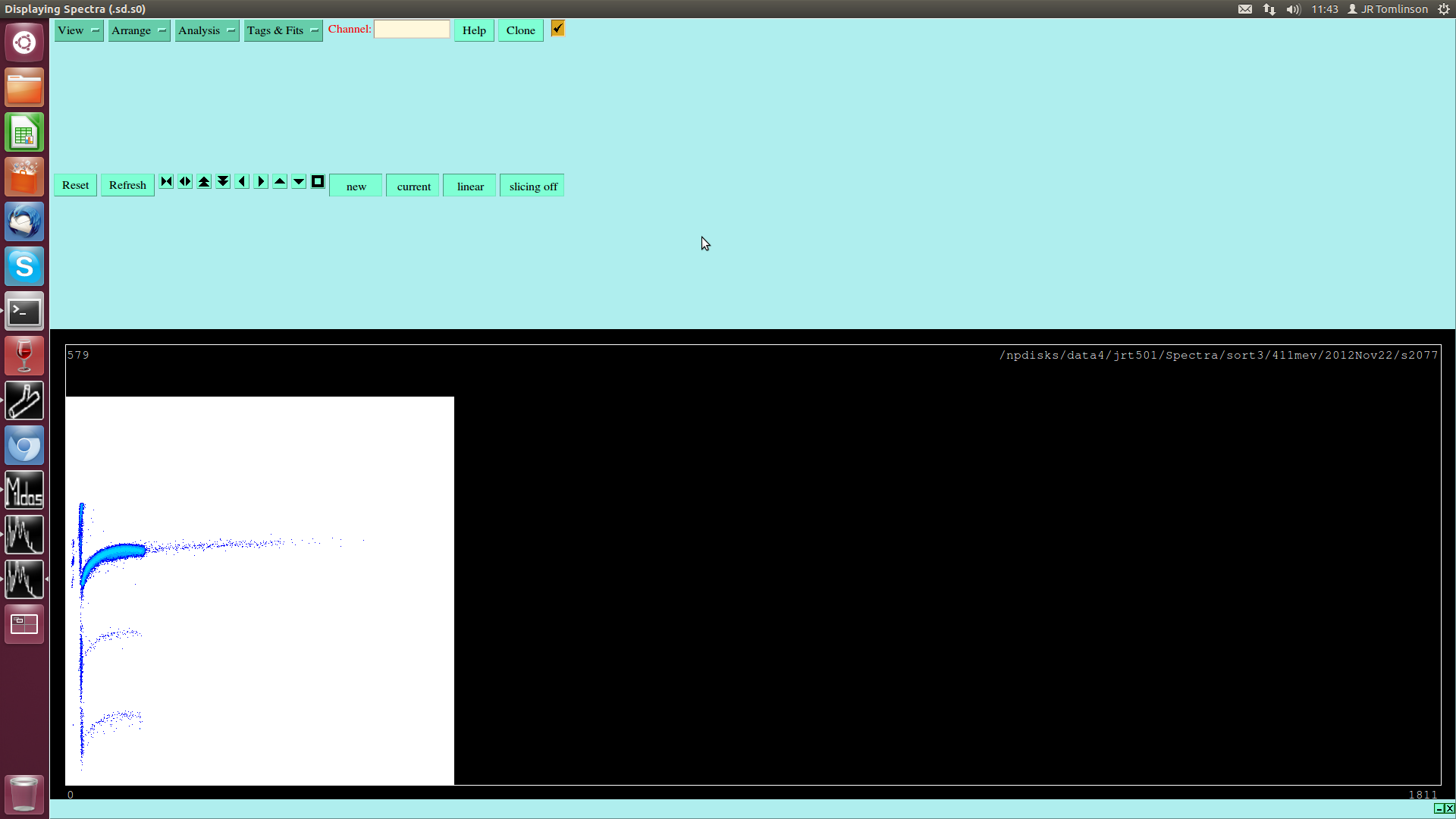
|
| Attachment 2: s2090-evst-s22-1strip.png
|
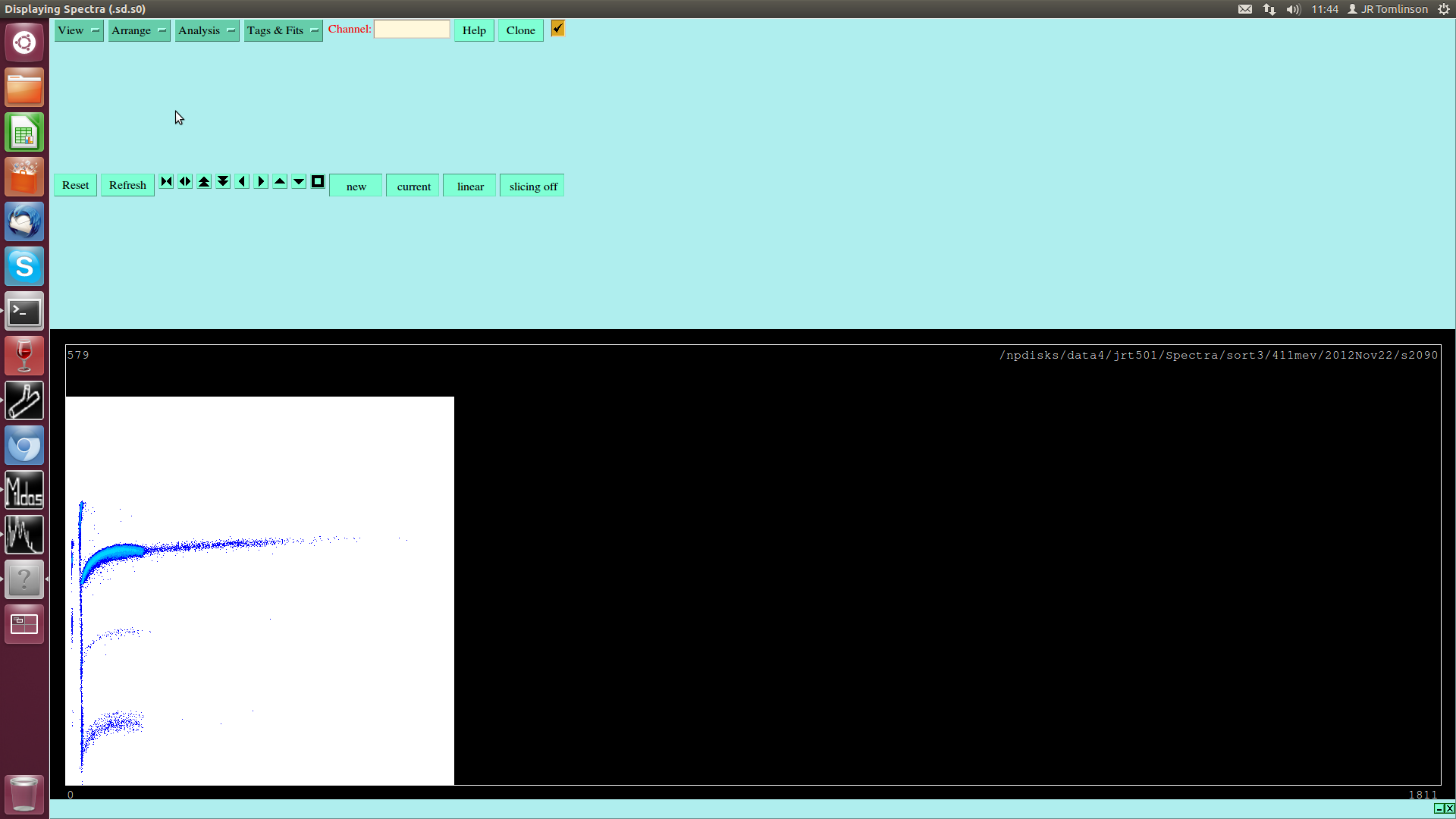
|
| Attachment 3: S2-2-Evst-p93bk4.png
|
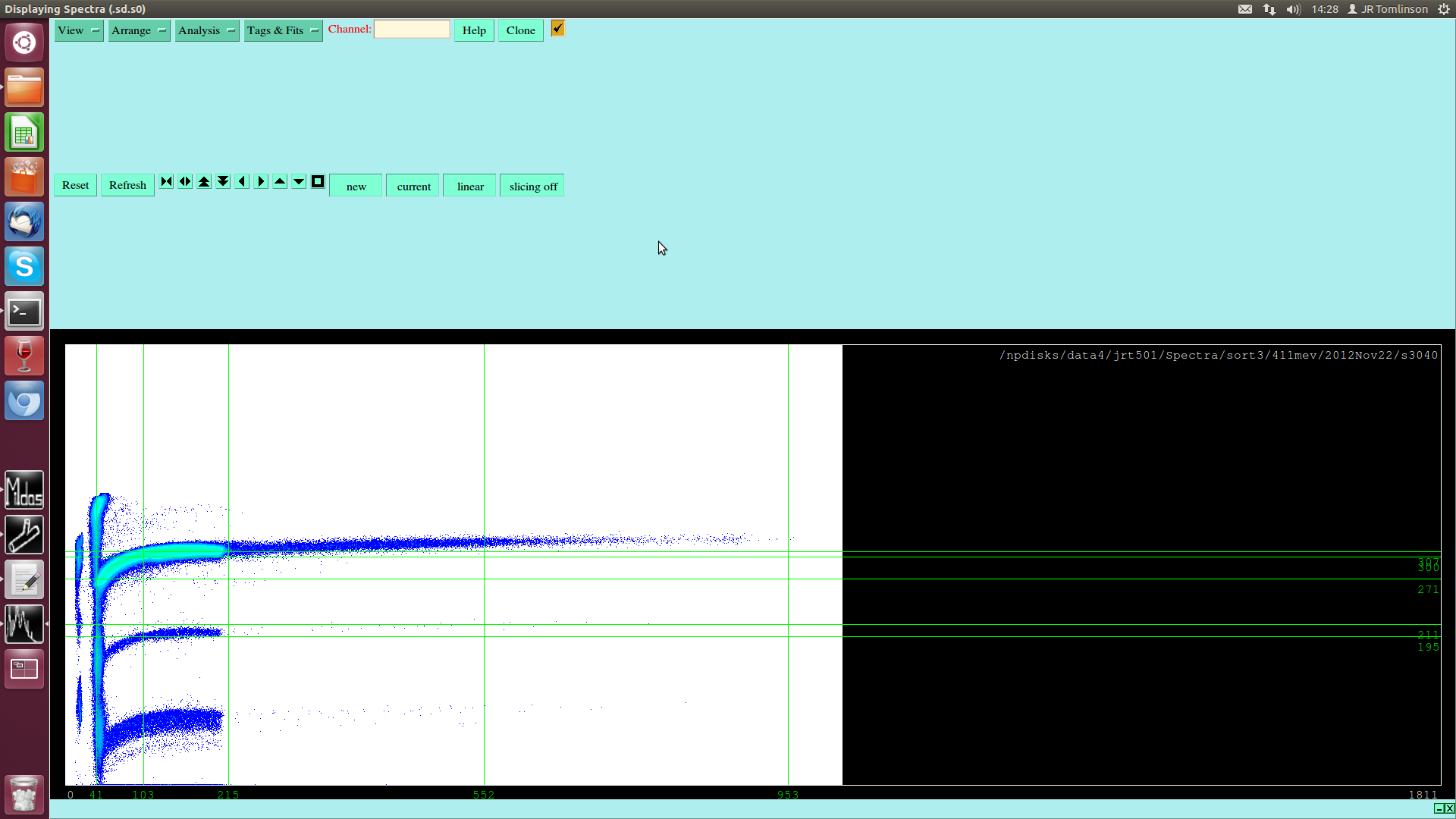
|
| Attachment 4: s2006-evst-s21-1strip.png
|

|
| Attachment 5: s2017-Evst-s21-1strip.png
|
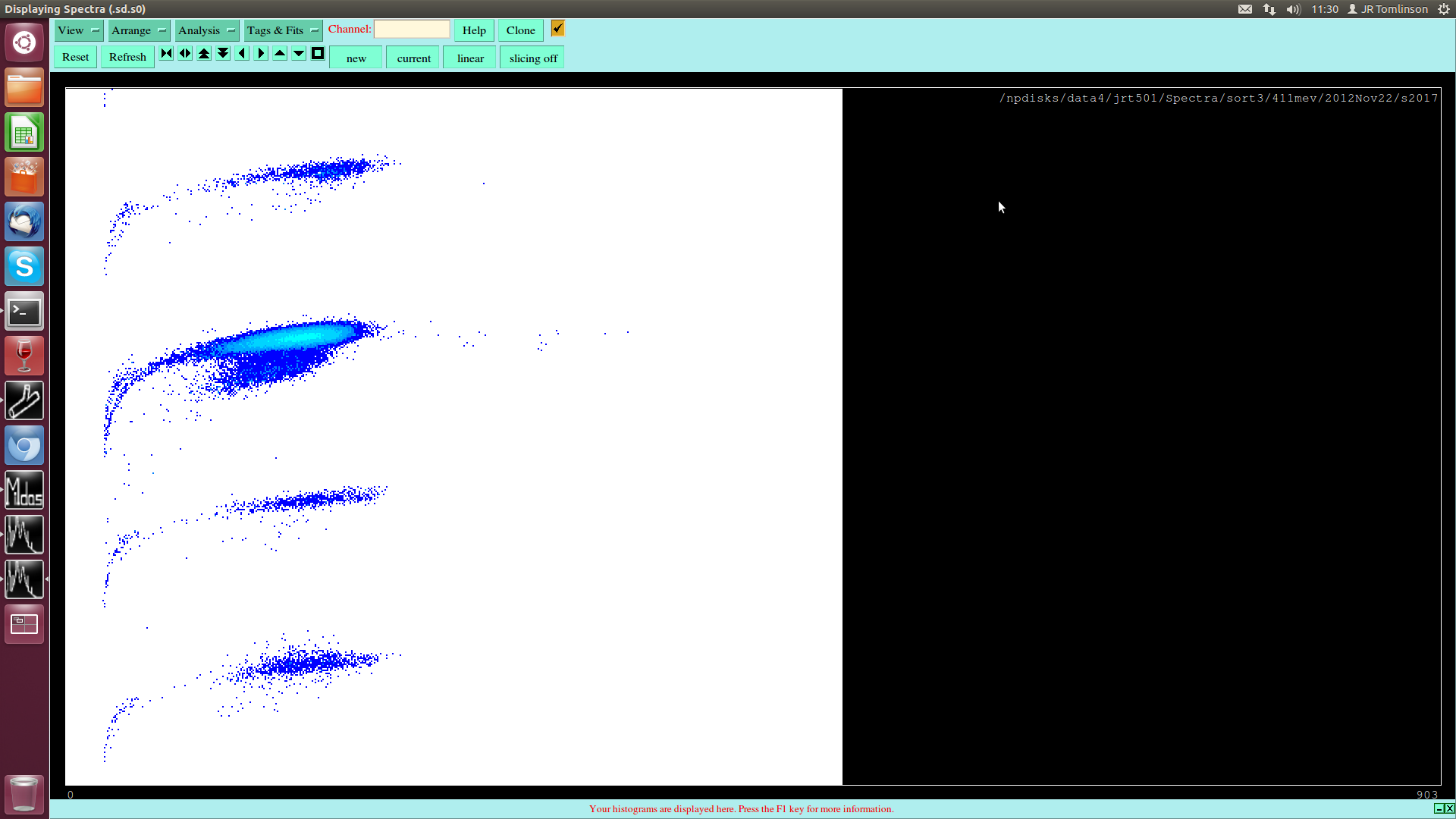
|
| Attachment 6: s2-1-Evst-p93bk4.png
|

|
|
|
60
|
Fri Jan 11 06:56:01 2013 |
Jessica Tomlinson | Other | General | multiplicities, hit patterns and good hits in an event |
I have attached a pdf of a series of slides with some multiplicity and hit pattern plots on, also a list of cuts. As well as this I looked at how many 'good hits' (explained in pdf) I am getting per event.
Before Christmas I found that the code was not clearing the raw arrays read in by MIDAS and so unless a new piece of data filled the array channel number the data from the last event was being read into the next event too. It was only clearing the 'data(i) arrays which is what the data is unpacked as. I have now got it clearing both so data is not read in for multiple events. |
| Attachment 1: 411mev-multiplicities-and-hitpat.pdf
|
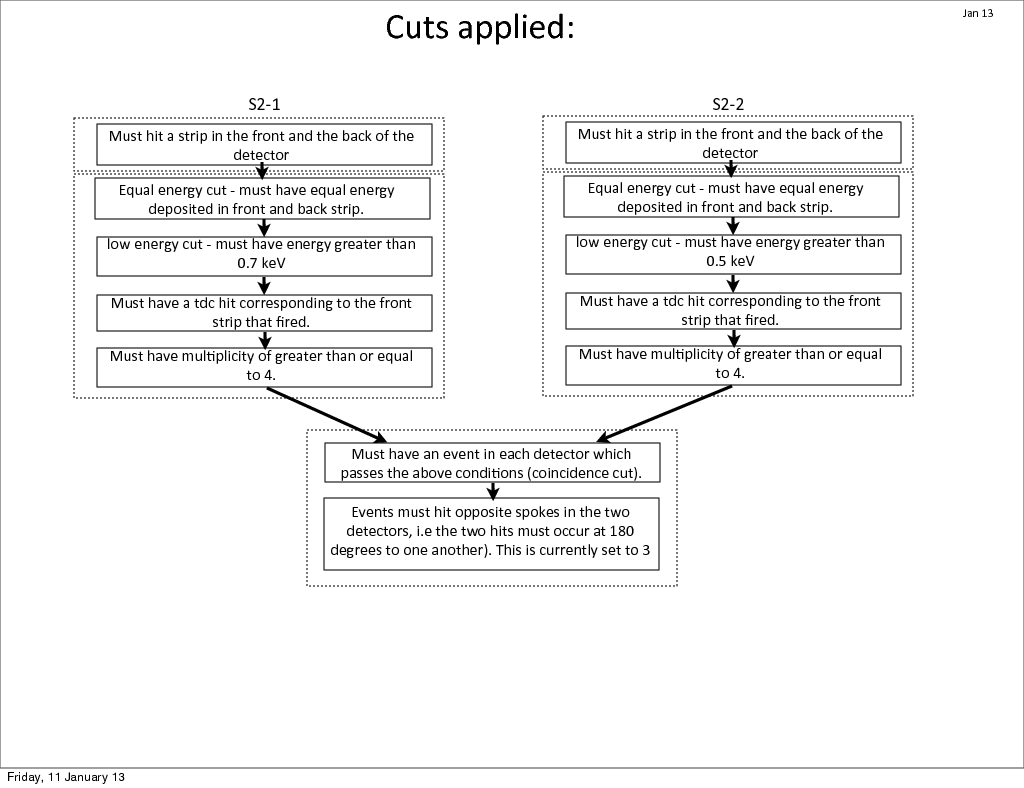
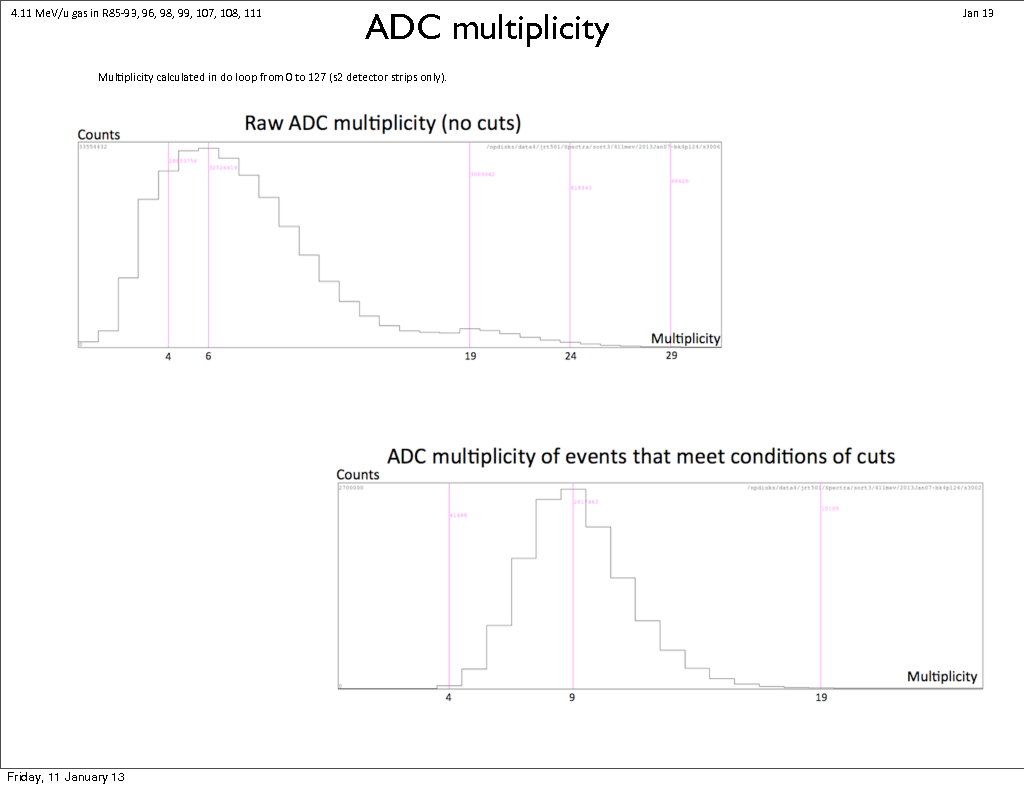
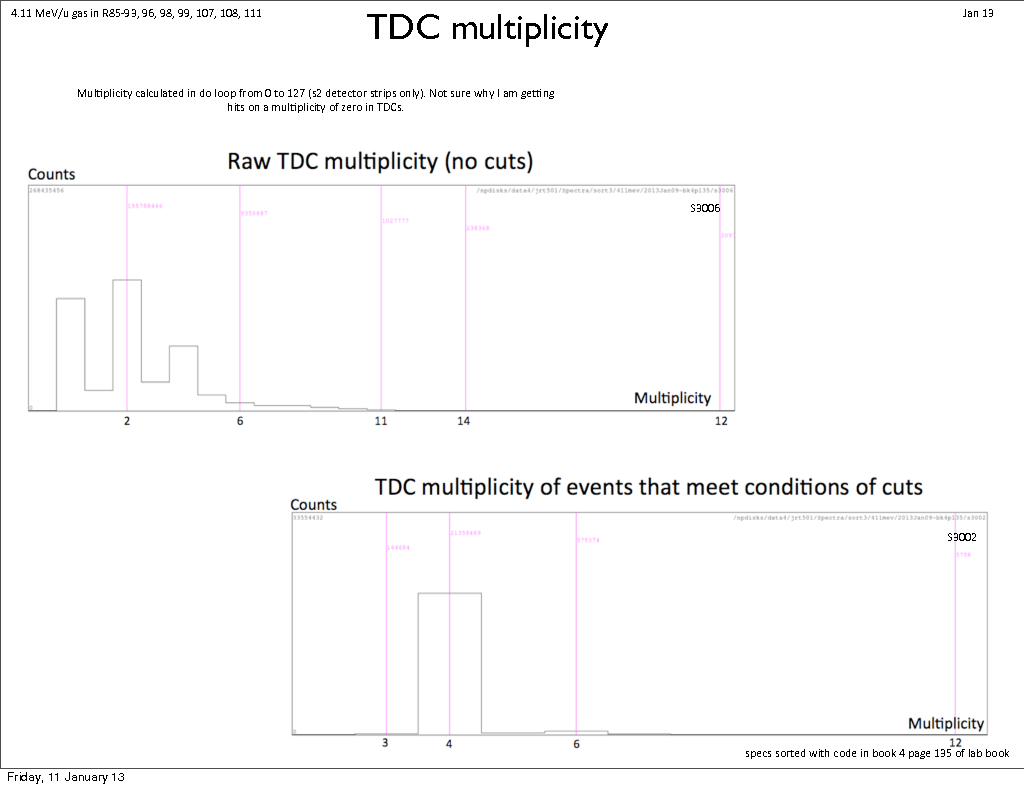
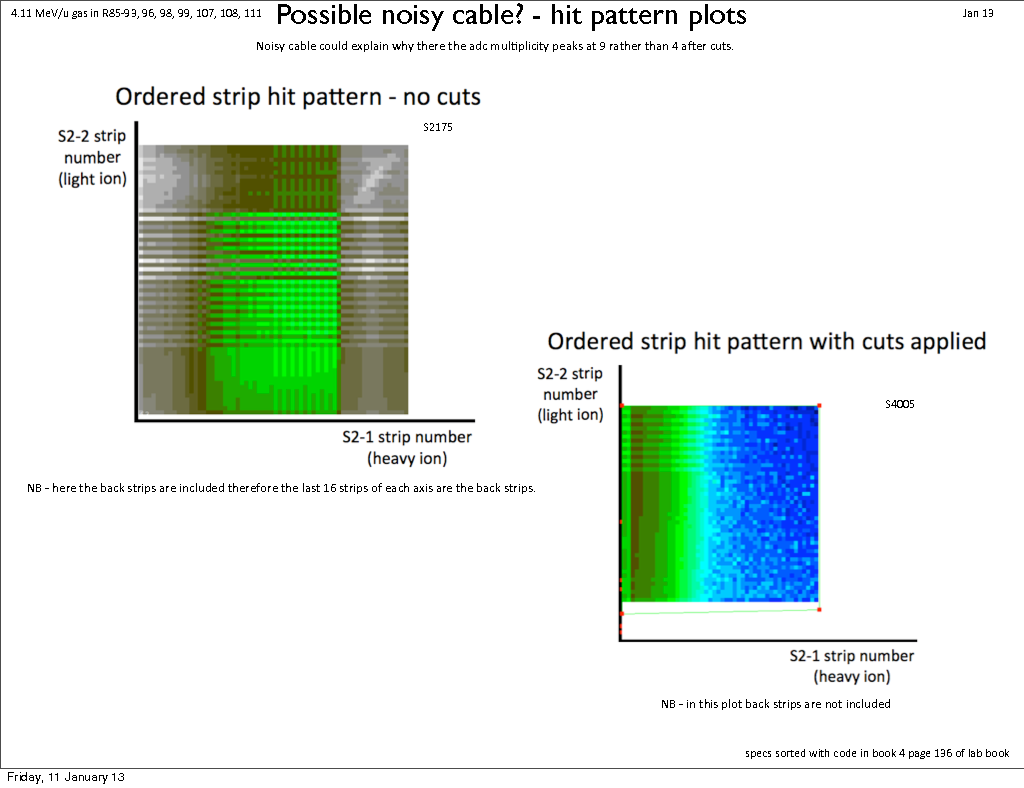
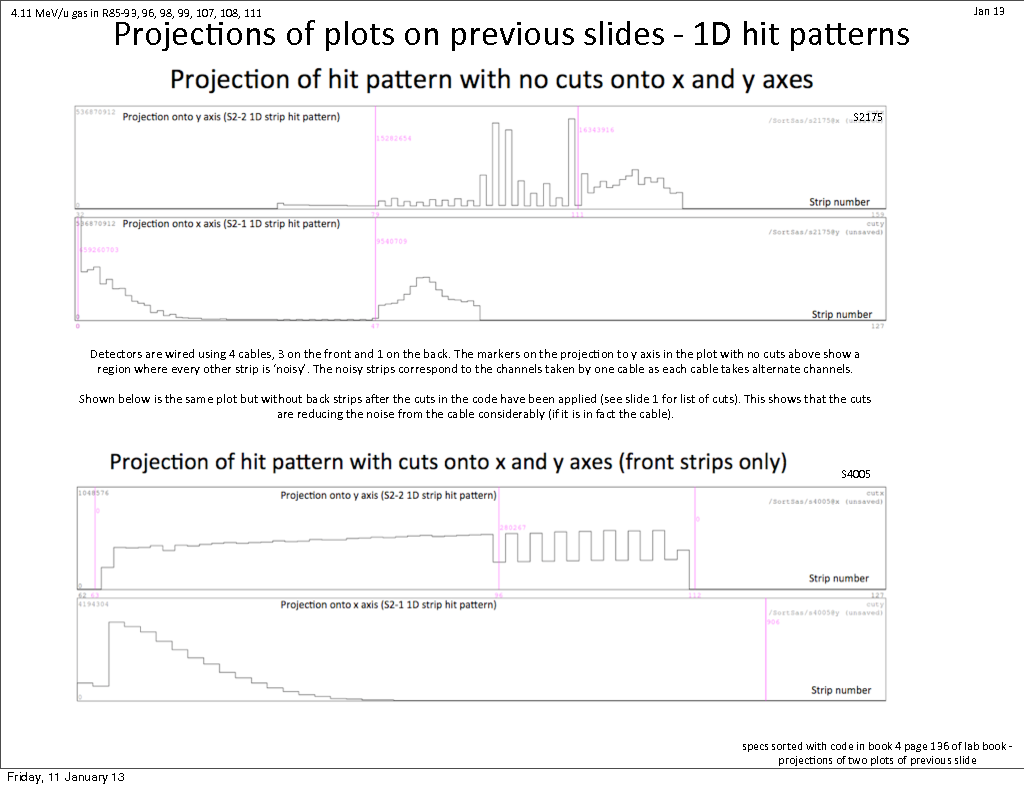
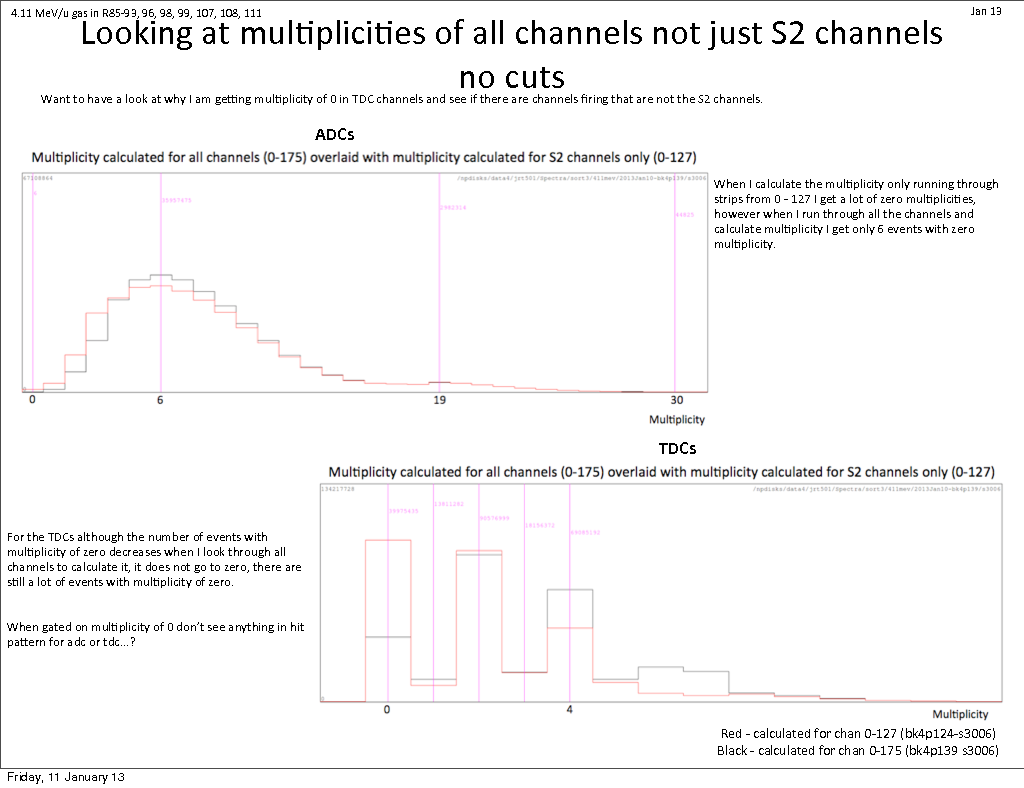
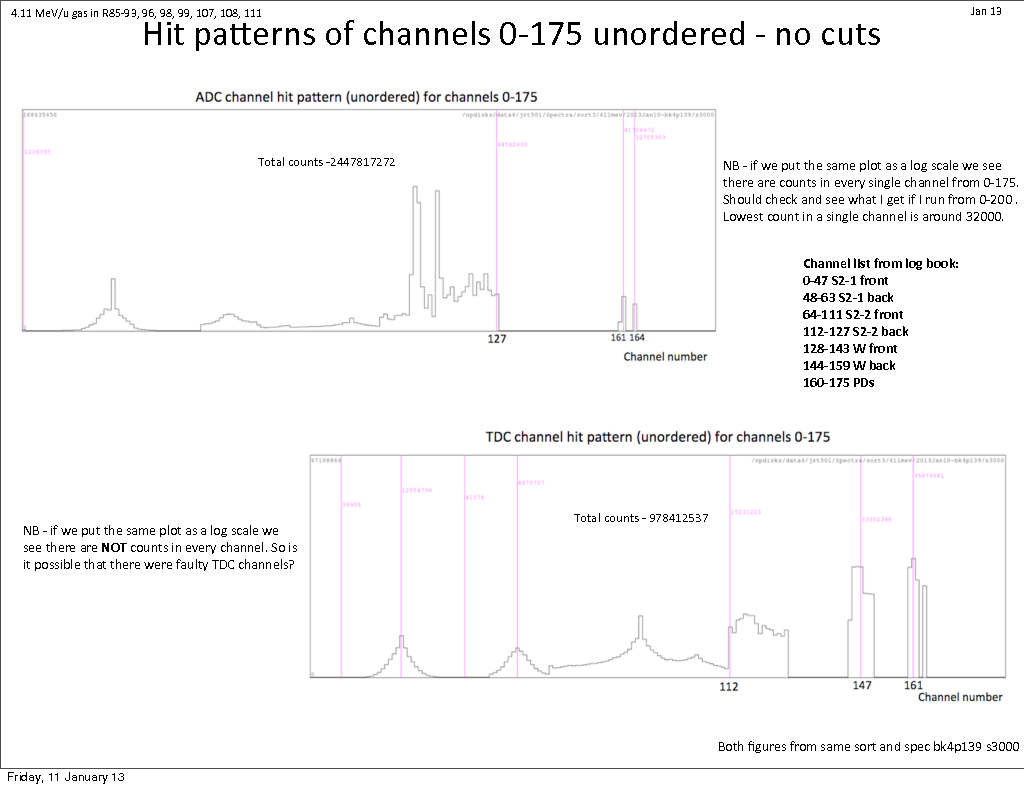
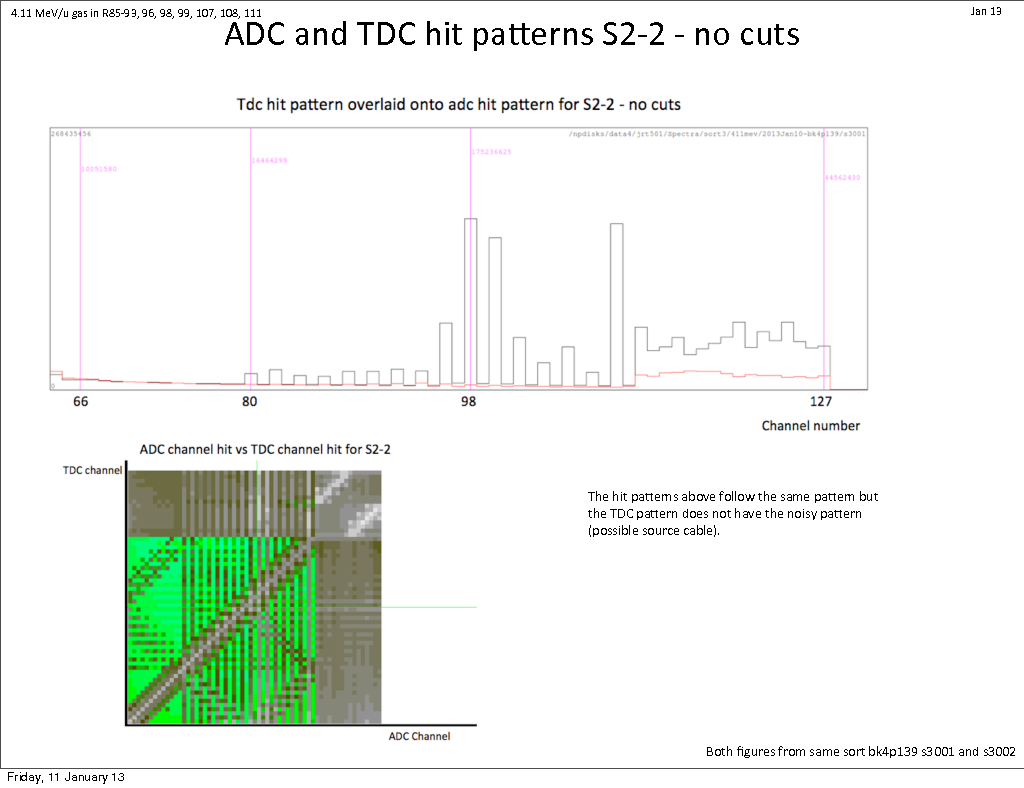
|
|
|
38
|
Tue May 24 23:59:16 2011 |
Jennifer Fallis, Lars Martin | Routine | General | Shift summary |
Buncher problem was resolved around 22:00 (driver module needed to be replaced).
Checked current on FC0 and trigger rate, around 4000 presented. We then started a run, only got 20 acquired,
stoped and restarted a run, then all relevant numbers seemed normal.
The pressure inside TUDA is slowly creeping down (~0.3 torr/h), maybe a small leak in the window. It's not the
hall cooling down, the gas temperature actually rose in the meantime. |
|
|
51
|
Sat May 28 10:07:44 2011 |
Jamie Brown, and Mike Bentley | | | Plan for last day |
1) PD run with gas (250Torr) - done
2) Pump down to 50 Torr - done
3) PD run - done
4) Take data (PD out) at 50Torr ~2 hrs. ~110epA - done
5) Pump out - done
6) PD run (no gas) - done
a) remove 5mm collimator and run without gas, ~100epA (no PD) - done
7) Complete H2 venting process - done
8) Open up, sources in (window off) - done
9) Pump down - done
10) alpha data (some of the S2-1 inner strips look very ill indeed , but all but one or two show clear triple-alpha peaks. - done
11) pulser walkthrough - done
12) vent and open up - done
13) dismount detectors and re-entrant flange - done
14) pub!
Done - finished at 7.30pm, pitcher of ale methinks. |
|
|
1
|
Mon Apr 4 01:34:54 2011 |
Jamie Brown | Routine | General | Proposal |
See attached. |
| Attachment 1: S1287_201007S_merged.pdf
|
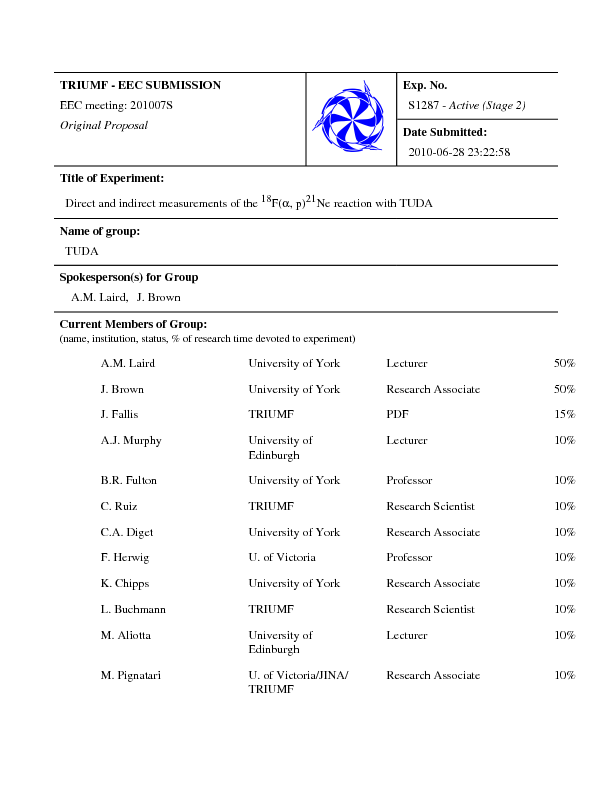
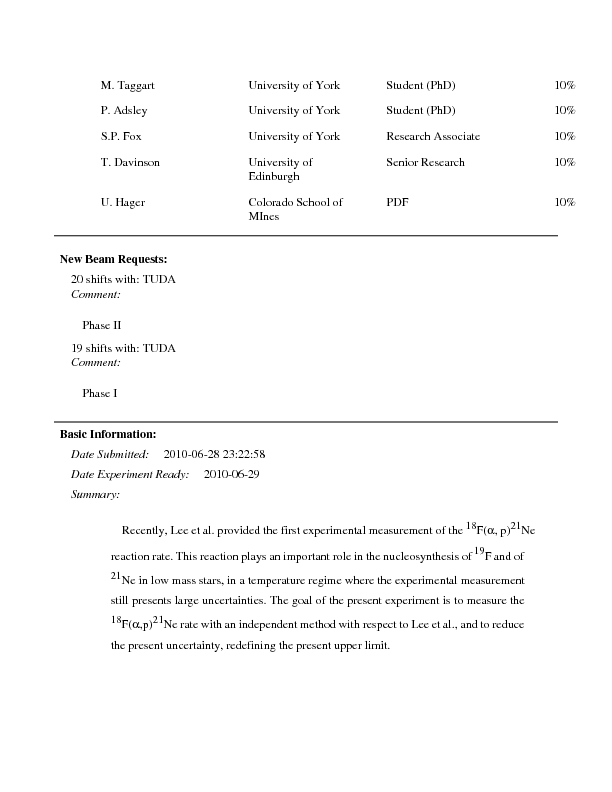

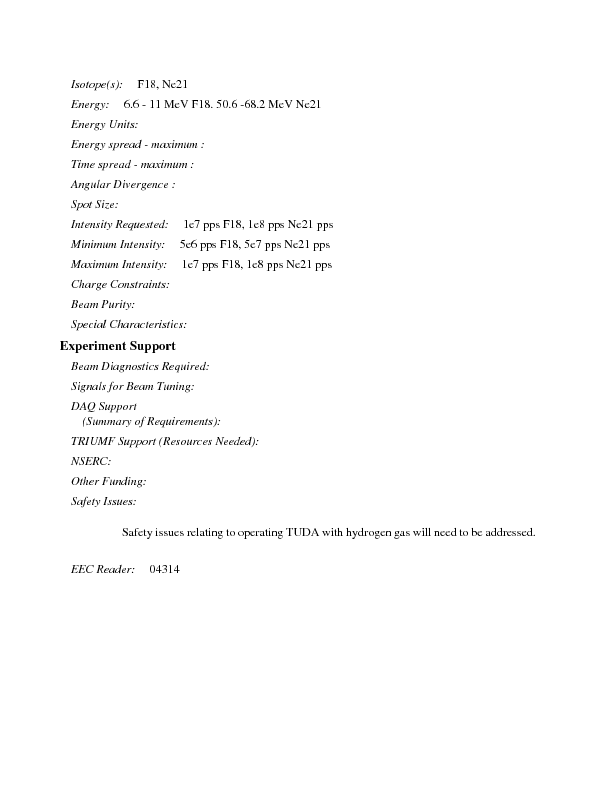
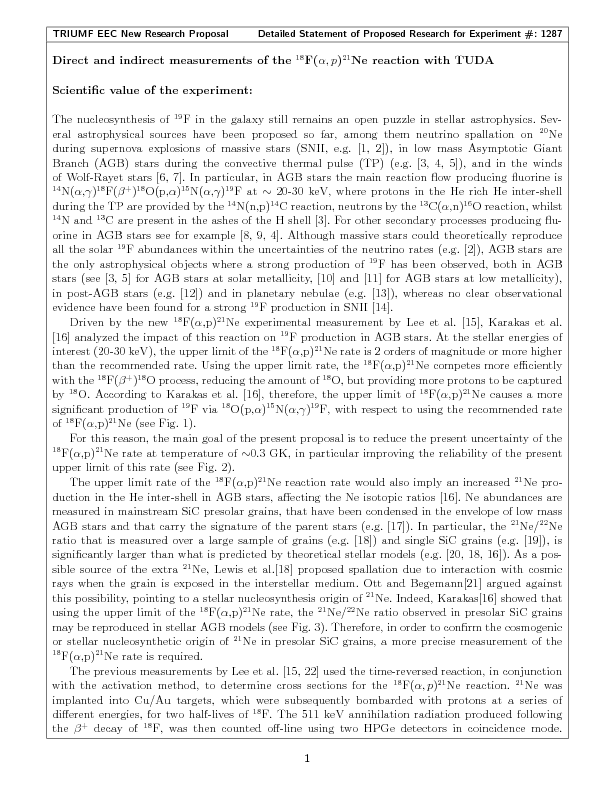
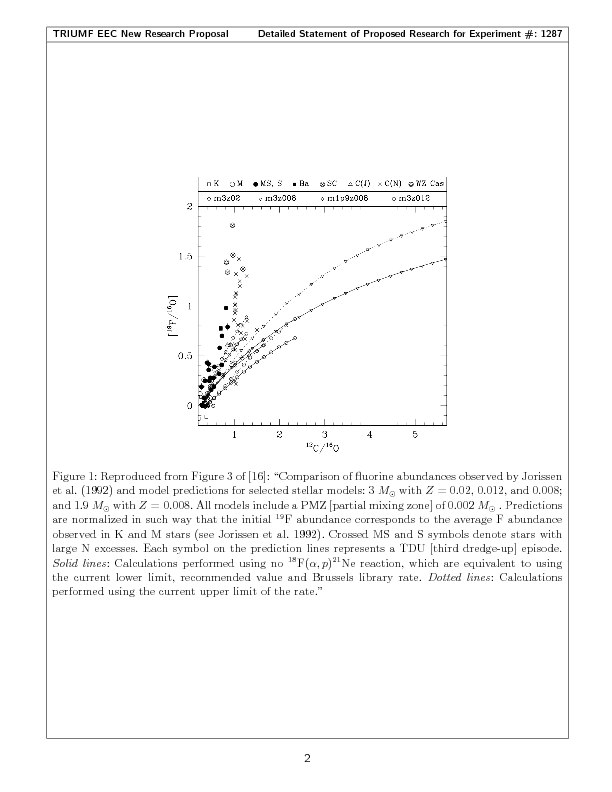

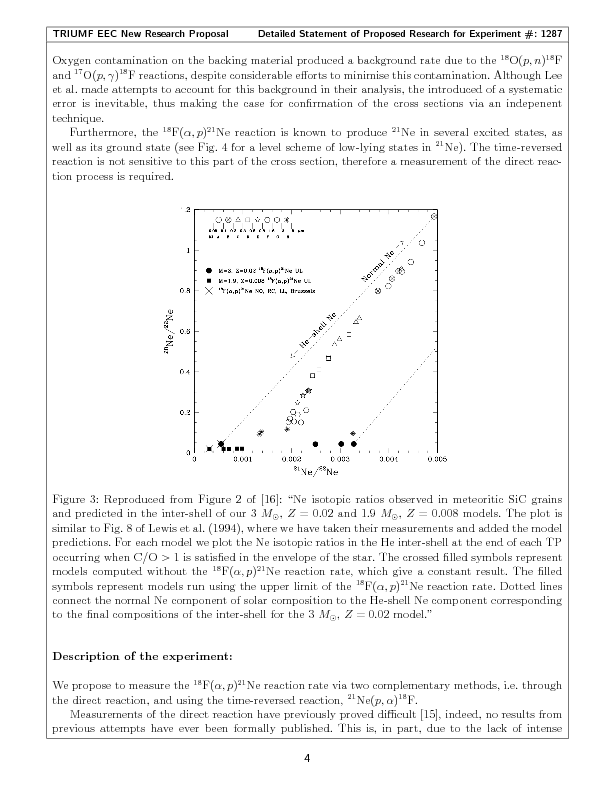
|
|
|
21
|
Mon May 16 21:14:19 2011 |
Jamie Brown | | | Broken solder on PD2 |
As you can see... |
| Attachment 1: PD2-broken_solder.png
|
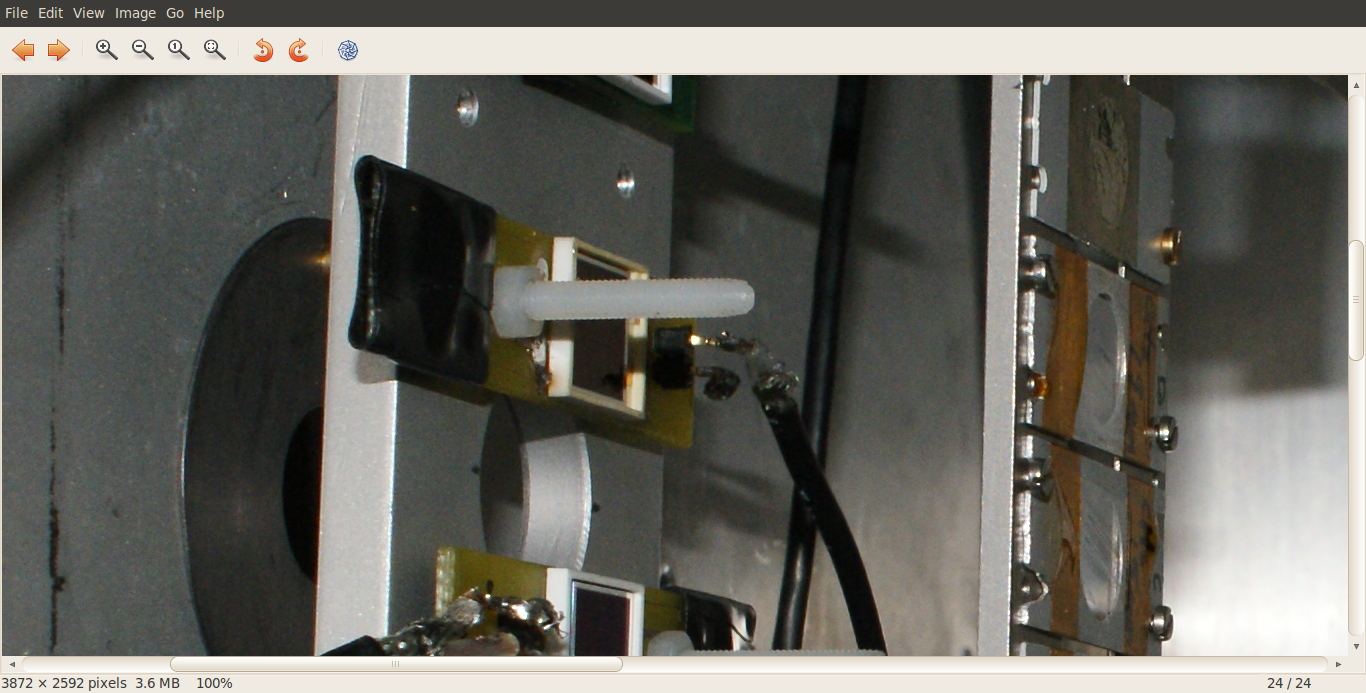
|
|
|
22
|
Tue May 17 12:32:13 2011 |
Jamie Brown | | | Thick carbon target |
The thick carbon target, to be used for background runs for the thick CH2 measurement was supplied by Marek.
He measured it to be 120um thick (with a micrometer), and says it's low density carbon (1.03g/cm3).
The range of a 68 MeV Ne beam in this is 67um.
Range of 16 MeV alphas is 266.5 um. |
|
|
27
|
Sat May 21 18:25:36 2011 |
Jamie Brown | | | Beam spot |
|
| Attachment 1: DSC05470.JPG
|
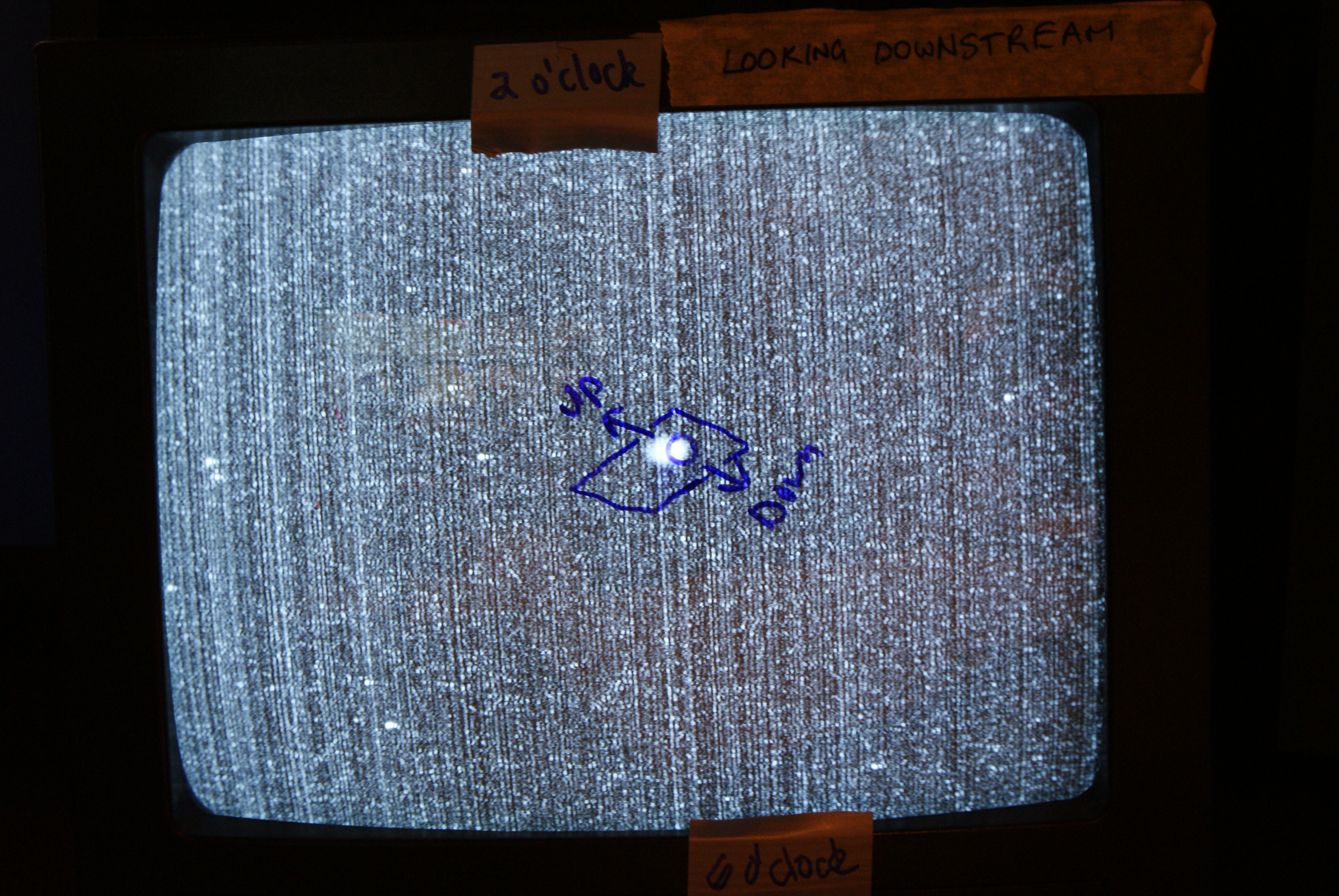
|
|
|
30
|
Mon May 23 02:16:32 2011 |
Jamie Brown | | | End of run summary |
Plan for shift was to increase trigger thresholds on S2-1 and S2-2 to cut out the low energy "stuff" which is dominating our trigger rate, and preventing us from increasing the beam current. S2-1 thresholds were at 10mV and S2-2 at 25 and 30mV.
Increased all S2-2 thresholds to 30mV and took runs with S2-1 at 11, 15, 20 and 40mV. Trigger rates seem unaffected. Low energy peak in S2-1 spectra are unaffected, however the bump at chn. ~380 was shifted up as threshold increased.
Looking at energy-energy spectra from sorted data, see lots of events at very low energy (y axis), across all channels (x-axis).
Concluded that the low energy peak is real coincidence, so can't be removed by increasing trigger threshold (as it is in coincidence with stuff in S2-2), and the "bump" is singles, so is being cut out as thresholds are increased.
Not clear whether the low energy peak is reactions, or something else, but the result is we can't increase the thresholds to cut the rate and allow the beam current to increase.
Following discussions with Brian, the interpretation of this may not be correct. |
|
|
42
|
Wed May 25 22:45:42 2011 |
Jamie Brown | | | Leakage current in S2-1 |
At approximately 7pm, noted that trigger rate in S2-1 had dropped by factor of ~20. Detector had tripped off due to leakage current reaching 8uA - spotting this was delayed as camera (or web-browser) monitoring currents had frozen. Current trip point has been increased to 12uA, and the beam intensity lowered to try to preserve the detector through out the night.
At some point this may be increased again but that will have to await a discussion of how much the detector can take. Replacing it would take ~6hrs so ideally we'd like it to survive until the end of the experiment.
For the time being we need to monitor the leakage closely (and ensure the web cam image is updating) and if the trip point is approached, either lower the beam current or switch off the detector for a while to allow it to recover, or both. |
|
|
45
|
Thu May 26 12:53:48 2011 |
Jamie Brown | | | H2 fill and vent procedures |
Please note that these procedures are not perfect and other small operations not listed may need to be carried out. Some mistakes may still exist in these procedures which could introduce significant risk if not spotted and corrected during the process. These should only be carried out by people confident they understand the system and the purpose of each step, giving due consideration to each step to ensure it is appropriate and safe.
In other words, don't blame me if it all goes horribly wrong! |
| Attachment 1: H2_filling_procedure.pdf
|
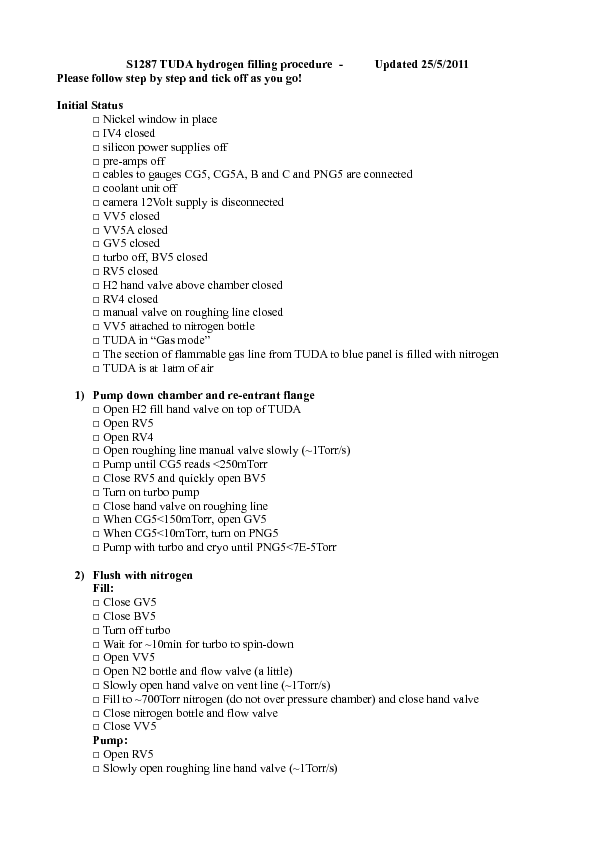
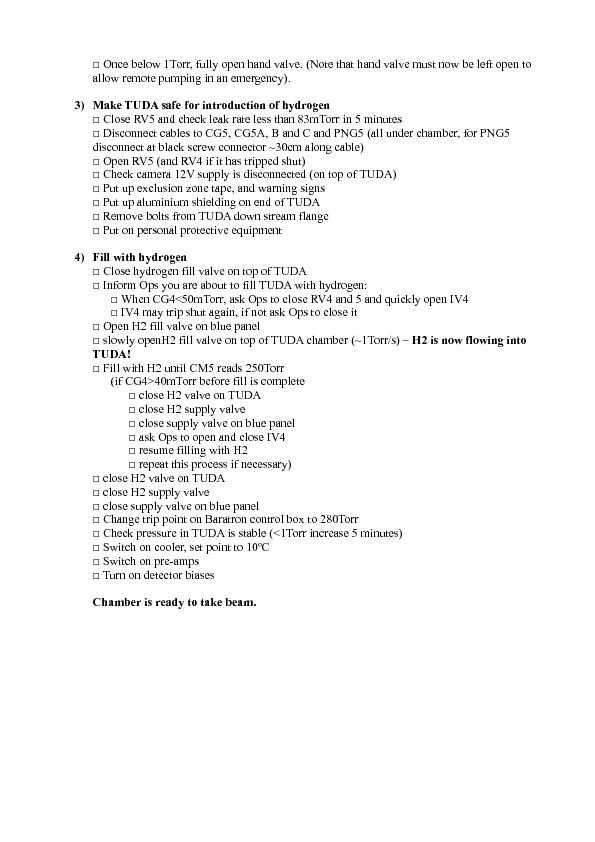
|
| Attachment 2: H2_venting_procedure.pdf
|
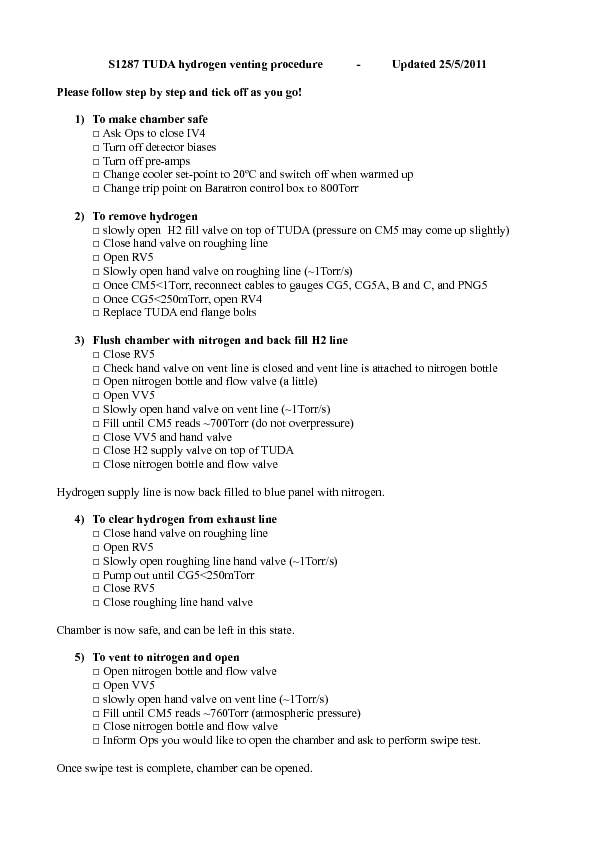
|